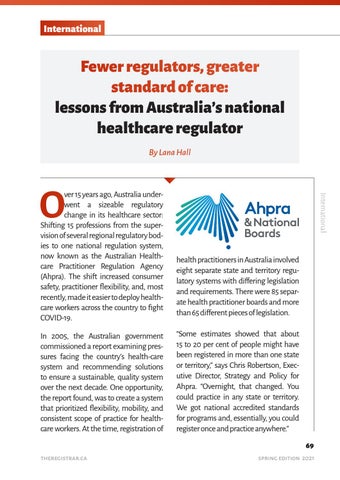International
Fewer regulators, greater standard of care: lessons from Australia’s national healthcare regulator By Lana Hall
In 2005, the Australian government commissioned a report examining pressures facing the country’s health-care system and recommending solutions to ensure a sustainable, quality system over the next decade. One opportunity, the report found, was to create a system that prioritized flexibility, mobility, and consistent scope of practice for healthcare workers. At the time, registration of
International
O
ver 15 years ago, Australia underwent a sizeable regulatory change in its healthcare sector: Shifting 15 professions from the supervision of several regional regulatory bodies to one national regulation system, now known as the Australian Healthcare Practitioner Regulation Agency (Ahpra). The shift increased consumer safety, practitioner flexibility, and, most recently, made it easier to deploy healthcare workers across the country to fight COVID-19.
health practitioners in Australia involved eight separate state and territory regulatory systems with differing legislation and requirements. There were 85 separate health practitioner boards and more than 65 different pieces of legislation. “Some estimates showed that about 15 to 20 per cent of people might have been registered in more than one state or territory,” says Chris Robertson, Executive Director, Strategy and Policy for Ahpra. “Overnight, that changed. You could practice in any state or territory. We got national accredited standards for programs and, essentially, you could register once and practice anywhere.” 69
theregistrar.ca
spring edition 2021
